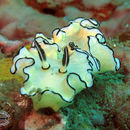en
names in breadcrumbs


Glossodoris atromarginata has cephalic tentacles on its head. These tentacles are sensitive to touch, taste, and smell. It has aposematic coloring to warn predators that it is poisonous.
Communication Channels: visual ; chemical
Other Communication Modes: mimicry
Perception Channels: ultraviolet; tactile ; chemical
Glossodoris atromarginata is not considered threatened or endangered. G. atromarginata is not listed by the IUCN.
US Federal List: no special status
CITES: no special status
State of Michigan List: no special status
In its early stages of life Glossodoris atromarginata looks very different from the adult. A free-swimming, shelled larva called a veliger is released from the egg. Shortly after hatching the shell is lost. While initially planktonic, the veliger eventually settles on the ocean floor where it metamorphoses into a juvenile. Development time can vary with water temperature.
Development - Life Cycle: metamorphosis
There are no known adverse effects of Glossodoris atromarginata on humans.
Glossodoris atromarginata is aesthetically appealing to snorklers and divers, and add to the beauty and diversity of marine life. However beyond their aesthetic appeal it has little to no significance to humans.
Positive Impacts: ecotourism
Glossodoris atromarginata will live on a sponge or coral its whole life. Sea slugs in general are hosts to parasitic copepods.
Commensal/Parasitic Species:
Glossodoris atromarginata is a carnivore, eating corals or sponges, particularly Hyatella.
Animal Foods: cnidarians; other marine invertebrates
Primary Diet: carnivore (Eats other marine invertebrates)
Glossodoris atromarginata is a common species of marine nudibranch native to the Pacific and Indian Oceans.
Biogeographic Regions: indian ocean (Native ); pacific ocean (Native )
Glossodoris atromarginata may be found in marine habitats such as reefs, inter-tidal areas and the deep ocean. However, it is generally found in shallow water. Most individuals live near or even on the surface of the water.
Range depth: 0 to 28 m.
Habitat Regions: tropical ; saltwater or marine
Aquatic Biomes: pelagic ; benthic ; reef
Other Habitat Features: intertidal or littoral
Glossodoris atromarginata has a life expectancy of 1 year in the wild. If captured, the life expectancy varies due to the conditions of the new environment and whether or not the species can adapt. Generally the expected lifespan for G. atromarginata is the same as for in the wild: 1 year.
Range lifespan
Status: wild: 4.5 (high) years.
Range lifespan
Status: captivity: 6 (high) years.
Typical lifespan
Status: wild: less than 1 to 1 years.
Typical lifespan
Status: captivity: less than 1 to 1 years.
Glossodoris atromarginata is an elongate sea slug that is white to creamish with a dark band down the dorsal midline. The mantle edge is very sinuous and has a dark brown to black margin. This sea slug has dark rhinophore clubs on the dorsal surface. Gills range in number from 14-22. The simple gills are also long, cream colored and have a dark margin. Glossodoris atromarginata will grow to 50-60 mm in length.
Range length: 60 (high) mm.
Average length: 40-45 mm.
Other Physical Features: ectothermic ; heterothermic ; bilateral symmetry
Sea slugs in general are preyed upon by crabs, lobsters, sea spiders, and other predatory sea slugs (e.g. Navanax inermis).
Sea slugs in general have been able to develop several defense mechanisms, including the ability to secrete toxic chemicals. It does this by retaining stinging cells from the animals that it ingests. Nudibranchs are also able to camoflouge themselves by taking on the color of anything they have eaten. These mechanisms can be used to scare off predators or inflict harm on the predator.
Known Predators:
Anti-predator Adaptations: aposematic ; cryptic
In general, nudibranchs are simultaneous hermaphrodites and produce both sperm and eggs. Two nudibranchs will exchange sperm sacs with each other to mate. Eggs are typically deposited on sponges. Gestation occurs over 5 to 50 days and in warmer waters, egg maturation occurs sooner.
Mating System: polygynandrous (promiscuous)
Range gestation period: 5 to 50 days.
Range age at sexual or reproductive maturity (female): 2 to 4 months.
Range age at sexual or reproductive maturity (male): 2 to 4 months.
Key Reproductive Features: simultaneous hermaphrodite; sexual ; fertilization (Internal ); oviparous
Larvae are free-living, and thus drift unprotected by either parent.
Parental Investment: no parental involvement; pre-hatching/birth (Provisioning)
Doriprismatica atromarginata is a species of sea slug. It is a dorid nudibranch, a shell-less marine gastropod mollusk in the family Chromodorididae.[2]
This species is found throughout the tropical and sub-tropical Indo-Pacific area.[3]
Doriprismatica atromarginata ranges in color from creamy-white through yellow to pale brown. It typically has a black-lined edge running down the outside of a very folded mantle and black rhinophore clubs. The frilly mantle sometimes appears to move like a wave as the animal crawls along. It can reach a total length of at least 60 mm.[3] This species is very similar in appearance to Doriprismatica sibogae and Doriprismatica plumbea, although Doriprismatica atromarginata is by far the more common and is not quite as deep yellow in colour as the other species.[3][4][5][6][7][8][9][10][11]
Doriprismatica atromarginata at Verde Island in the Philippines
Doriprismatica atromarginata in Komodo, Indonesia
Doriprismatica atromarginata at Verde Island, the Philippines
Doriprismatica atromarginata feeds on sponges and has been seen feeding on the species Hyatella intestinalis.[3] The species is capable of obtaining metabolites from its food source, and uses them to protect itself against predators.[12]
Doriprismatica atromarginata is a species of sea slug. It is a dorid nudibranch, a shell-less marine gastropod mollusk in the family Chromodorididae.